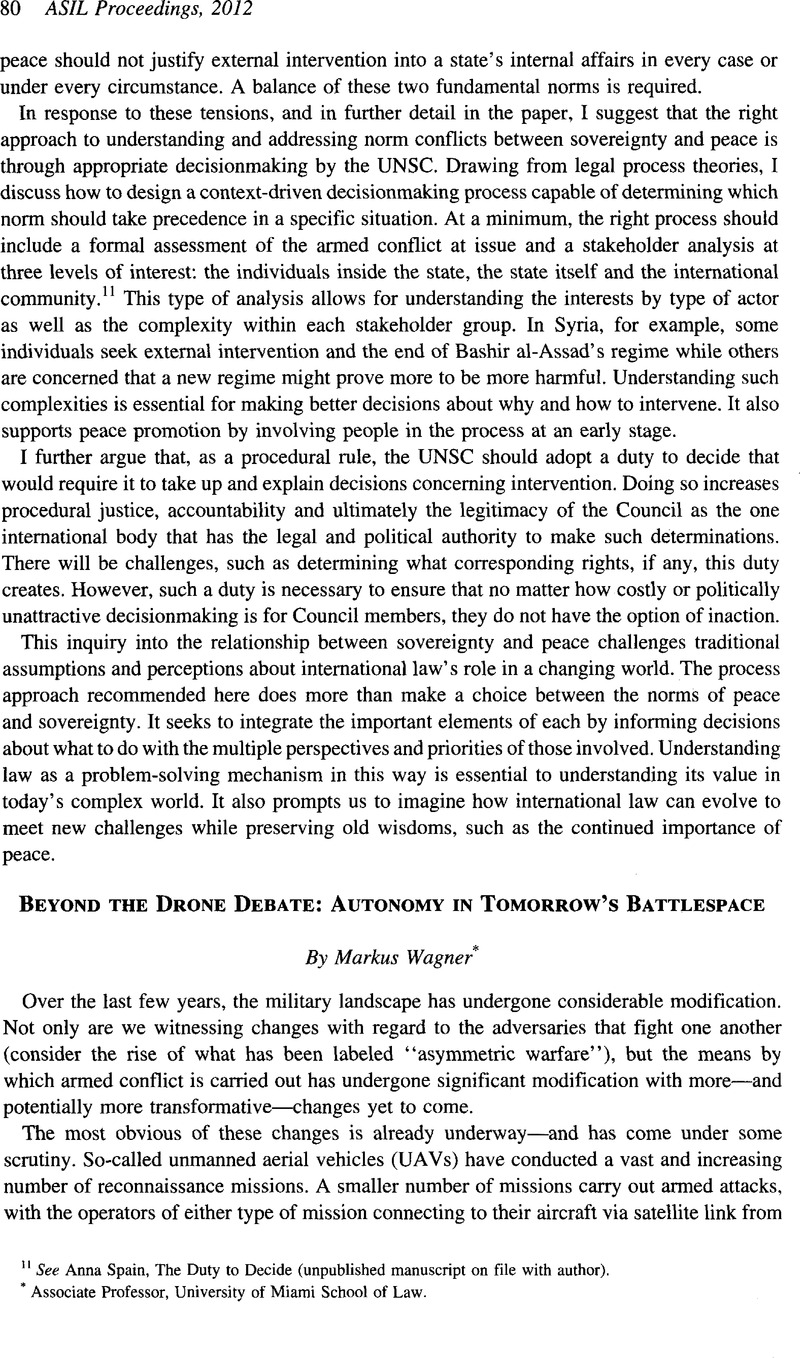Article contents
Beyond the Drone Debate: Autonomy in Tomorrow’s Battlespace
Published online by Cambridge University Press: 28 February 2017
Abstract

- Type
- New Voices I: Humanizing Conflict
- Information
- Copyright
- Copyright © American Society of International Law 2012
References
1 See, e.g., Mayer, Jane, The Predator War—What Are the Risks of the C.I.A.’s Covert Drone Program?, New Yorker, Oct. 26, 2009, at 36 Google Scholar. In the wider context of targeted killing and its international legal implications, see also Study on Targeted Killings: Report of the Special Rapporteur on Extrajudicial, Summary or Arbitrary Executions, Philip Alston., No. A/HRC/14/24/Add.6; Kretzmer, David, Targeted Killing of Suspected Terrorists: Extra-Judicial Executions or Legitimate Means of Defence?, 16 Eur. J. Int’l L. 171 (2005)CrossRefGoogle Scholar; Melzer, Nils, Targeted Killing in International Law (2008)Google Scholar; O’Connell, Mary Ellen, The International Law of Drones, 14 ASIL Insights 1 (2010)Google Scholar.
2 Peter W. Singer, Wired for War: the Robotics Revolution and Conflict in the Twenty-First Century 47-48 (2009).
3 Wagner, Markus, Taking Humans Out of the Loop: Implications for International Humanitarian Law, 21 J. L., Info. & Sci. (2011), 155 (157)Google Scholar available at http://papers.ssrn.com/sol3/papers.cfm?abstract_id=1874039.
4 This taxonomy does not mean that an AWS could not be operated via remote control or automatically. Rather, AWS can operate in any of these modes, depending on the circumstances.
5 Both principles are firmly established not only in international treaty law, but according to the International Court of Justice in its Nuclear Weapons Advisory Opinion, The rules pertaining to the principle of distinction “constitute intransgressible principles of international customary law.” Legality of the Threat or use of Nuclear Weapons, Advisory Opinion, I.C.J. 1996, 226, para. 79. See also Shelton, Dinah, International Law and “Relative Normativity,” in International Law 159, 164, 166 (Evans, Malcolm D. ed., 2d ed. 2006)Google Scholar.
6 See Additional Protocol I art. 51(4).
7 See Wagner, supra note 3.
8 See Boothby, William H., Weapons and the Law of Armed Conflict 79 (2009)Google Scholar; O’Donovan, Oliver, The Just War Revisited 62 (2003)CrossRefGoogle Scholar; Dinstein, Yoram, The Conduct of Hostilities Under the Law of International Armed Conflict 131 (2d ed. 2010)CrossRefGoogle Scholar.
9 International Criminal Tribunal for the former Yugoslavia (ICTY), Final Report to the Prosecutor by the Committee Established to Review the Nato Bombing Campaign Against the Federal Republic of Yugoslavia (June 8, 2000), 39 ILM 1257 (2000).
10 Gillespie, Tony & West, Robin, Requirements for Autonomous Unmanned Air Systems Set by Legal Issues, 4 Int’l C2 J. 1, 13 (2010)Google Scholar.
11 Dinstein, supra note 8, at 133; Franck, Thomas M., On Proportionality of Countermeasures in International Law, 102 AJIL 715, 729 (2008)CrossRefGoogle Scholar. For a different view, see Prosecutor v. Stanislav Galić, IT-98-29-T (Dec. 5, 2003) (ICTY Trial Chamber), para. 104 et seq. (separate and partially dissenting opinion of Judge Nieto-Navia).
12 Dinstein, supra note 8, at 132; New Rules for Victims of Armed Conflicts: Commentary on the Two 1977 Protocols Additional to the Geneva Conventions of 1949, at 310 (Michael Bothe, Karl Josef Partsch & Waldemar A. Solf eds., 1982).
13 Beard argues similarly because of the better sensory abilities of the current generation of UMS. Beard, Jack M., Law and War in the Virtual Era, 103 AJIL 409, 428 et seq. (2009)Google Scholar.
14 Ronald C. Arkin, Governing Lethal Behavior in Autonomous Robots 29 et seq. (2009); Quintana, Elizabeth, The Ethics and Legal Implications of Military Unmanned Vehicles, at 13 Google Scholar, Royal United Services Institute for Defence and Security Studies, at http://www.rusi.org/downloads/assets/RUSI_ethics.pdf.
15 Mental Health Advisory Team (MHAT) IV, Operation Iraqi Freedom 05-07, Final Report, at 4 (2006).
16 Guarini, Marcello & Bello, Paul, Robotic Warfare: Some Challenges in Moving from Noncivilian to Civilian Theaters, in Robot Ethics: the Ethical and Social Implications of Robotics, 129, 136 (Lin, Patrick et al. eds., 2012)Google Scholar. See also Bandes, Susan A., Is it Immoral to Punish the Heedless and Clueless? A Comment on Alexander, Ferian, and Morse: Crime and Culpability, 29 L. & Phil. 443 (2010)Google Scholar.
- 1
- Cited by




